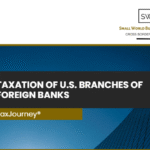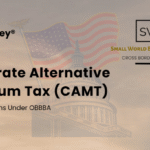Cross-border M&A remains a significant growth area for U.S. based businesses, providing market, technology, and capital opportunities. However, the tax consequences of cross-border transactions have become significantly complicated due to multiple jurisdictions, evolving treaty interpretations, and overlapping or even contradictory compliance requirements, which pose increased challenges for deal teams and CFOs.
TaxJourney® offers a U.S. focused framework to help dealmakers, tax professionals, and investors navigate cross-border M&A tax complexities. This edition covers key issues like withholding mismatches, treaty documentation, FTC planning, and state compliance, providing strategic insights to structure deals and mitigate risk.
- Cross-Border Growth – Expanding into new markets requires careful tax planning.
- Treaty Benefits – Tax treaties can reduce or eliminate double taxation.
- Foreign Tax Credits – Proper use of FTCs lowers effective tax exposure.
- Compliance – Multi-jurisdictional reporting demands robust systems.
- Risk Mitigation – Anticipating risks protects value and smooths integration.
Cross-Border M&A Tax Complexity – Current Challenges?
Cross-border M&A provides new avenues for growth, but the IRS has made negative changes that have a large impact on deal structuring. Companies and deal teams also face various challenges, including:
- Increasing Compliance Complexity for Multi-Jurisdictional Deals – With every foreign jurisdiction involved in the cross-border transition comes its own reported standards, filing requirements, and tax laws, all of which need to be sorted through at the same time, putting massive pressure on compliance teams.
- Debated Tax Regimes, Tax Treaty Related Claims & Reporting Obligations – Tax treaties are agreements between jurisdictions to minimize double taxation. However, it still may be challenging to properly interpret the tax treaties or to properly apply the treaty benefits. Generally speaking, dealing with tax treaties will often have inadvertent consequences for our clients that may unnecessarily expose them to more tax than was originally intended, while at the same time extending the closing timeline.
- IRS Increasingly Watching Certain Cross-Border Tax Transaction Structures – With the IRS expanding their watching eyes on cross-border transactions, they are not only focused on related party transfers pricing but also on foreign tax credits, and treaty-based positions. The best deal teams can do is max out their documentation and maintain it in a defensible structure to avoid operational challenges or disputes or penalties.
Key Compliance Pillars
Robust U.S. tax knowledge is essential to the viability of cross-border M&A. Four fundamental pillars have significant implications for deal planning and execution:
- Permanent Establishment (PE) Rules – Understanding the PE rules and when a U.S. taxing jurisdiction may emerge from business being conducted, U.S. taxpayers often do not scrutinize the foreign activity sufficiently to detect that they have created a PE, and vice versa for foreign taxpayers tax, authorities, will promote optimal structuring during deal capture and allow for the mitigation of best tax practice for the target.
- Foreign Tax Credits (FTC) – The appropriate claim of FTC is necessary for any company or MNE to mitigate double taxation in the U.S. by claims for foreign tax paid. Optimal handling of the FTC calculation during deal planning will lead to improved valuation modelling and potentially assist in negotiations.
- GILTI and BEAT Exposure – For a U.S. MNE, GILTI and BEAT have a very significant influence on outbound and inbound M&A structuring. Deciding on deal structuring at the front end to ensure certainty and to minimize unintended tax leakage is essential to deal success.
- Treaty Interpretation to Optimize Tax Performance – U.S. tax treaties provide scope to mitigate withholding tax, seek treaty benefits, and optimize tax efficiency of deals. Successful application of treaty provisions require making sure that appropriate supporting documentation is progressed, and due diligence becomes crucial.
Navigating Cross-Border Deal Tax Challenges
Cross-border M&A deals require multiple tax systems to be effectively addressed and, oftentimes, even minor blunders can result in unanticipated liabilities, extended deal timelines, and/or a shrinking deal value. Two of the paramount areas to plan around are jurisdictional differences in tax and treaty-based planning.
Jurisdictional Differences
Tax rules vary greatly across countries, with the failure to reconcile jurisdictional tax rules potentially affecting the results of the transaction as follows:
- Withholding Taxes on Cross-Border Payments – Dividends, interest, and royalties paid between jurisdictions are often subject to withholding taxes. Erroneously applying treaty rates or planning for these obligations can increase overall tax cost and reduce after tax returns on the deal.
- Capital Gains Tax Variation – Variety in capital gains taxes applied in different jurisdictions exists based on different rates and different events being taxable. Without a coordinated plan there’s a risk the buyer or seller have unexpected exposure that has an impact on the negotiations and price of the deal.
- Foreign Exchange (FX) Impacts – Currency fluctuations and foreign exchange (FX) gain or loss tax treatment can complicate valuation models. Advance planning can help protect the economics of the deal and maintain forecasts.
- Transfer Pricing Rules across Jurisdictions – Arm’s length prices must be established for cross-border transactions. Transfer pricing policies are regularly applied inconsistently resulting in scrutiny, audits, and dual taxation unless they are carefully aligned with local and U.S. requirements.
| Jurisdictional Factor | Risk / Challenge | Impact on Deal |
| Withholding Taxes | Incorrect treaty application | Higher tax costs & reduced after-tax returns |
| Capital Gains Variation | Different rates & taxable events | Unexpected exposure affects pricing & negotiations |
| FX Impacts | Currency fluctuations & tax treatment | Distorted valuations & unreliable forecasts |
| Transfer Pricing | Misaligned policies | Audits, disputes & potential double taxation |
Treaty Considerations
Tax treaties are essential to alleviating cross-border tax burdens, but they are not always simple to use, especially on the fly as part of a multi jurisdictional deal:
Why Treaties and Taxes Matter?
U.S. tax treaties are a valuable feature that will often lower withholding rates, remove double taxation and offer some specific relief from taxation relating to the cross-border transactions. Structuring deals with efficient tax treaty treatments in mind will often lead to much increased cash flows and returns once the deal is completed.
Why You Should Prepare Documentation?
To get treaty benefits, you need documentation IRS Form W-8BEN/E or residency certificates. Any missing or misfiled documentation could lead to denied relief, unwanted leakage of tax, could lead to denied relief and unwanted tax leakage.
Leveraging Tax Treaties in Cross-Border M&A
Efficient treaty planning unlocks tax savings and maximizes deal returns.
Why Treaties Matter?
- U.S. tax treaties can lower withholding rates.
- Prevent double taxation across jurisdictions.
- Enable smoother cross-border deal structuring.
- Drive higher cash flows and post-deal returns.
Why Documentation Matters?
- Submit IRS Form W-8BEN/E or residency certificates to claim treaty benefits.
- Missing or misfiled documents can deny treaty relief.
- Documentation gaps can cause unexpected tax leakage.
- Proper filing prevents disputes and delays in deal closings.
Proactive treaty planning + accurate documentation = smoother closings and optimized tax outcomes.
M&A Structuring Considerations
A good framework for cross-border M&A deals is imperative to minimizing tax exposure, maximizing value post-deal and is subject to some situation, which may comprise citizenship or residence of the parties in the deal, relevant tax treaties, and overall business plan considerations.
Outbound vs Inbound Tax Implications
Tax implications of cross-border deals are quite different, depending on whether the deal is inbound or outbound deal.
Inbound Transactions (Foreign acquirors purchasing U.S. companies):
The specific focus areas in this kind of transaction will be, withholding taxes, treaties application, IRS Form 5472 reporting requirements on foreign-owned U.S. entities. Additionally, the buyers will need to look at exposures at the state and local level, which might not reflect federal treatment.
Outbound Transactions (U.S. buyers purchasing foreign companies):
The emphasis usually tends to be on foreign tax credits (FTC), local taxation management, and repatriation of profit from abroad earned. In cross-border deals outbound, it is necessary to appreciate GILTI and BEAT exposure, U.S. acquiror considerations.
Key Takeaway:
Cross-border M&A deals structuring involves balancing the U.S. federal jurisdiction rules, a foreign jurisdictions taxation, and any application of treaty relief to achieve the maximum tax efficiency for the two parties involved.
Strategic Vehicle Selection
Selecting the right vehicle will determine the tax result and compliance requirements extensively:
- Subsidiaries – A preferred method when assessing tax treaties and limiting liability. Accessing preferential withholding tax rates under U.S. or foreign tax treaty agreements.
- Branches – Easier to establish a branch, but direct exposure to foreign tax may arise. Often if operational presence is needed immediately in a target country.
- Hybrid Entities – Hybrid entities are structured to allow for regulatory tax flexibility, allowing companies to take reporting deductions, withholding minimizations, or dual treatment for income tax in other jurisdictions. Hybrid entities are effective when you’re aligning U.S. tax and foreign tax in the combined tax reporting.
Key Takeaway:
The best vehicle will depend on the transaction, country of transaction, and the long term operational plan. Planning your tax early will allow you to ensure the structure is conducive to compliance and operational effectiveness and efficiency in cost containment.
Choosing the Right Vehicle for Cross-Border M&A
Strategic Vehicle Selection: Impacts tax outcomes, and operational efficiency
Subsidiaries:
- Preferred for treaty benefits
- Reduces liability exposure
Branches
- Quick to establish, faster market entry
- Direct exposure to foreign taxes
Hybrid Entities
- Offers tax flexibility across jurisdictions
- Allows dual tax treatment benefits
Key Takeaway:
The optimal structure depends on the transaction type, jurisdiction, and long term operational strategy. Early planning ensures compliance and cost efficiency.
Practical Steps – Checklist for Deal Teams
To execute an effective cross-border M&A transaction, a systematic, phased approach is essential. Each phase of the transaction contains tax implications and integrated across each phase will influence value and compliance.
Pre-Deal Phase
The groundwork for a successful crossing-border deal is laid before deal negotiations commence. Proactively thinking through pre-deal tax planning has the potential to minimize any unplanned tax exposures as you advance your transaction with your target within cross-border interpretations:
- Confirm Treaty Benefits → Review relevant applicable U.S. and foreign treaties to take advantage of cross-border withholding tax rates and minimize the double taxation of income.
- Model Foreign Tax Credits (FTCs) → Model FTCs to determine amounts that limit or eliminate tax leakages that impact transaction valuations and prevent deals from closing due to tax principles.
- Review GILTI and BEAT Impacts → Evaluate a U.S. multinationals’ exposure regarding GILTI and BEAT when they enter or exit from a foreign jurisdiction.
During the Deal
Tax diligence during the transaction is critical to efficient deal structure and avoiding unpleasant last minute surprises:
- Confirm Withholding Tax Requirements → Based on a review of residency certificates from all parties for all cross-border payments to ensure the appropriate treaty withholding tax rates are all applied correctly.
- Structure Asset vs. Stock Purchase → Ultimately the preferred structure will vary based on tax efficiency, desired liability exposure and integration strategies post acquisition.
- Consider Transfer Pricing Compliance → Intercompany pricing policies will need to also be structured to abide by U.S. tax requirements and foreign localized tax requirements. Maintain a low audit risk profile by managing tax compliance policies between the related each entities.
Post-Deal Phase
When the deal closes, ensuring compliance and optimizing long term tax efficiencies as priorities:
- Plan for Repatriation Strategies → Identify the optimal tax efficient mechanism to repatriate profits back to parent entities, whilst minimizing additional tax exposure.
- Track Foreign Reporting Obligations → Ensure timely completion of filings such as for Form 5471 and other jurisdictional requirements, to avoid penalties.
- Maintain Treaty Compliance → Review the treaty based positions and supporting documents to ensure ongoing eligibility for reduced withholding rates and relief based on treaty.
Key Takeaway:
By establishing transaction phases ensures the deal team can address tax exposures much earlier in the transaction phase, structure transaction tax efficiently, and ensure compliance post-closing and during integration. Proactive planning is the difference between value being created and costs, in cross-border M&A.
Key Takeaways and Strategic Insights
Cross-border M&A can create an enormous number of opportunities for growth, international expansion, and shareholder value creation. But organizations must recognize that in an environment of changing U.S. and global tax rules, complicated treaty implications, and increased regulatory scrutiny, proactive tax planning is a must.
To create maximum value and mitigate risk, CFOs, dealmakers and tax leaders can:
- Plan for tax risks earlier so structures are developed with respect to timelines associated with the transaction.
- Optimize structures and transaction placement, to ensure operationalization of treaty benefits while increasing tax efficiency.
- Use phased tax diligence to monitor disclosures and develop an integration strategy.
- Leverage the use of technology and AI enabled insights to improve accuracy, speed, and reduce risk.
Organizations can create tax efficiencies, mitigate risk and drive sustainable value from cross border M&A activity through planning and structure.
The information contained in this post is merely for informative purposes and does not constitute tax advice. For more information, feel free to reach us at [email protected]
Copyright 2025 Small World Business Advisors LLC www.swbadvisors.com













